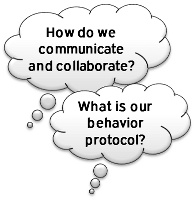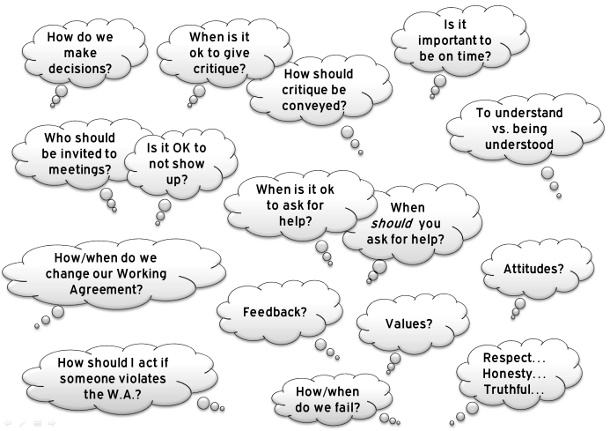 All teams have some sense of what is regarded as acceptable or good behavior within the team. Most people know that colleagues don’t appreciate it when you’re late. Perhaps you have a silent agreement regarding how you vote and make decisions. Some teams write down their behavior and collaborative “protocol” in a Working Agreement.
All teams have some sense of what is regarded as acceptable or good behavior within the team. Most people know that colleagues don’t appreciate it when you’re late. Perhaps you have a silent agreement regarding how you vote and make decisions. Some teams write down their behavior and collaborative “protocol” in a Working Agreement.
You might think that common sense covers it and writing it down seems silly, but surprise – common sense is subjective and you will have different opinions about things. Great! Let’s discuss and find our common ground.
The act of discussing it and writing it down is also a strong team building activity and forges relationships between team members. Any new team, or any team for that matter, could benefit greatly from a one-hour workshop. It could be part of a retrospective or a stand-alone meeting.
A Working Agreement (WA) can answer questions like these…
Keep it short and alive
Make sure the Working Agreement isn’t too long. Ever heard of the 68 commandments?
No, that’s because there were ten.
But don’t write them in stone. Ensure that the Working Agreement becomes a living document, that you review it once in a while. Remove bullet that feel obsolete and add new agreements.
One way to approach such a workshop could be:
- Everyone spends five minutes writing down suggestions on post-its.
- Take turns presenting a WA bullet. Discuss. Use consensus thumb voting. If in disagreement, discuss some more and vote again, or move on to the next person and continue with the next suggestion. If you reach consensus, keep the bullet.
- Continue until all suggestions have been discussed, or the meeting time box is up.
- Create a “Working Agreement” poster with the consensus bullets.
- Everyone signs the poster.
- Put it up on the wall.
It is vital that everyone agrees on every bullet and the way it is phrased. If someone disagrees and says that he/she won’t honor a bullet in the W.A. (and the team fails to rephrase the bullet so that he/she can commit to it) then it doesn’t belong in the working agreement.
It’s about integrity
It’s about creating a great collaborative productive environment – and about integrity. Christopher Avery defines it like this; “Integrity is the ability for a system [team] to maintain integrity even under pressure”. If you (and everyone in the team) decides to never be the first one to defect then you are off to a great start.
Some examples
If you want some examples of other teams Working Agreements, you can find them here and here. Keep in mind that these WA:s reflect the needs for those specific teams and probably won’t apply to your team and your needs.





Tackar Jimmy. Har gjort detta massor av gånger, men blir ändå inspirerad av att läsa detta.
I do not agree on this definition alone of working agreeement, here you are talking about behaviours and values , but you are neglecting operationnal agreements. For example : every month , we go over our strategy as a team. Or Every 3 weeks, we review our kata Behaviours . These are also elements part of working agreement. The way I see it , I see one dimention is operationnal and organisational , another dimension is behaviours and a third dimension is Values .